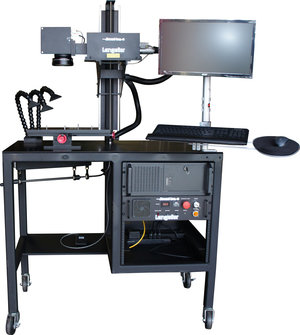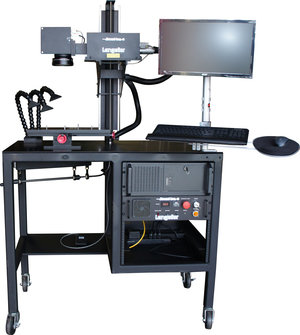Why might I want a beam expander for my laser marking system?
Let’s start by describing what a beam expander does. A fixed expansion ratio beam expander...

 Here at Jimani we get a lot of questions about what actually goes into our fiber laser marking systems. What follows is an outline of the major components that make up a Jimani Langolier fiber laser marking system and a little about what those components do.
Here at Jimani we get a lot of questions about what actually goes into our fiber laser marking systems. What follows is an outline of the major components that make up a Jimani Langolier fiber laser marking system and a little about what those components do.
IPG Photonics is the name of the company that manufactures the fiber laser module that is used in the system. We use IPG YLP fiber laser modules in our laser marking systems. The 'Y' refers to a Ytterbium fiber laser and we use a Q switched version of that laser.
Ytterbium is the active lasing medium in the laser. It is the material that gets excited in order to produce laser light. Yetterbium fiber lasers work on the same materials as older Nd:YAG lasers and the Nd in those lasers refers to neodymium which is the active lasing medium in a YAG laser. Suffice it to say that ytterbium is the stuff inside of the laser that lets it produce laser light.
A pulsed Q switched fiber laser refers to how the laser operates. A CW laser, for example, is a laser that produces a continuous beam of light, like a flashlight. It has a lot of average power but does not have enough peak power to vaporize material. When marking most items, the focused laser beam is actually vaporizing material on the surface of the item in order to produce the marks. A pulsed Q switched laser has the laser light coming out in pulses. Each pulse has very high peak power and this is what is needed in order to vaporize material. The act of producing these high peak power pulses is called Q switching. So we are using a laser that has ytterbium as the active lasing medium and it produces Q switched pulses of light when it operates.
The laser beam has to be steered into a lens in order to move it around the surface of the part to be marked. This is accomplished by a scanhead. The scanhead is a device that uses two galvanometers which are like very fast, highly accurate servo motors. Each galvanometer has a mirror attached to its shaft and the laser light reflects off of those mirrors. One mirror steers the beam in the X axis through the focusing lens and the other mirror steers the beam in the Y axis through the focusing lens. By coordinating the motion of these mirrors, the scanhead allows the laser to "draw" on the part. The particular scanhead that we use is made by a company named Scanlab and the model of the scanhead (or scanner) is the hurrySCAN.
The RTC-4 board is a control board. It takes the information from the laser marking software (Prolase) and converts it into signals that are sent to the scanhead and to the laser. The RTC-4 board controls the motion of the mirrors in the scanhead and turns the laser on and off at the proper time in the proper sequence.
All laser marking systems of this type must have a laser, scanhead, control board and marking software. They must also include a means of housing and mounting the optical components, including the laser module, and provide the control electronics and power supplies to make things work and communicate properly.
A class I or Class IV workstation refers to the US government's classification of the laser system configuration. About 30 or so years ago, the US government decided to classify lasers. This is now regulated by a government agency named CDRH (Center of Devices for Radiological Health). A Class I laser refers to a laser system that allows no human access to laser emissions. A class IV workstation refers to an open frame system that has a Class IV laser on it. All laser marking sytems employ a Class IV laser but the ultimate classification of the system is determined by the housing surrounding the laser. When anyone, like Jimani, builds a laser product, that product must be registered with CDRH before it is introduced into commerce. Jimani manufactures both Class I and Class IV laser system products.
The I/O refers to the Input and Output control signals that are available within the Prolase software via the RTC-4 board. These I/O signals can be used if some type of automation is connected to the system. These I/O signals can communicate with external devices such as a rotary indexer. These external devices can use their own controller and simply "handshake " with the marking software, or use a Jimani provided servo controller which allows the marking software to take full control of the external device.
There you have it - these are the things that make up our Langolier Fiber Laser Marking Systems.
Contact Jimani and see what they can do for you with a state of the art fiber laser marking system.
Let’s start by describing what a beam expander does. A fixed expansion ratio beam expander...
I believe that anything that is made can and will fail one day. I’m dismayed when I see advertising...
OXNARD, California – February 21, 2011. Jimani Inc. introduces the Desktop Langolier, a versatile,...